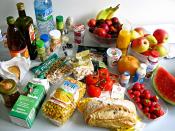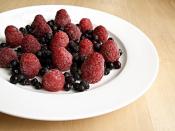Food Sites on the Net: Useful Information, Easy Advertising Dollars, or Both?In a day and age where technology has revolutionized the way we live and communicate, the food industry is no exception. Gone are the days of digging through old and torn cookbooks for a recipe or having to wonder just what ingredients are necessary for that lavish dish. The internet has connected experts with knowledge of all that encompasses food to people that desire this information ÃÂ literally any recipe can be found on the internet from a multitude of sources. Technical assets like the internet can turn your average Joe into a chef of epic proportions, and more people are turning to their computers for healthy alternatives to traditional meals as they pay closer attention to exactly what they eat. Examining popular food web pages such as FoodNetwork.com, Los Angeles Times Food, Yahoo! Food, and Cuisine.no.cz all reveal interesting information about the food information industry on the internet.
As it ascends to a larger scale of popularity, the information placed on these websites, including selected articles, seasonal recipes, and deliberately placed advertisements will have an increasing effect on its target audience from beginner chefs to food aficionados looking to perfect their style.
Exploring these food-related websites, one can gain much insight on everything from recipes and cooking, holidays and parties, quick and easy dishes, healthy eating, and even recipes seen on ever-so-popular television cooking shows. This creates a large target audience because columns appeal to almost everyone having a remote connection to food ÃÂ whether you are throwing a party and looking for tips on being a good host and great dishes to prepare, cooking a romantic dinner for two and looking to add some special spice to a dish, or if you are looking to change your consumption habits and curb them toward a healthier lifestyle, there are hundreds of articles available at your fingertips. Pictures featured on these websites, especially Food NetworkÃÂs, make all dishes look delectable through various sharpening and photo-editing effects. This creates appeal and sparks interest in potential customers. One particularly intriguing website lets the viewer input as little as four ingredients currently present in their refrigerator and can whip up a list of potential dishes using just these select items ÃÂ dinner never has be boring again!Despite having a vast amount of food-related tips and advice, many of these web pages did not have all too much to do with everyday eating. Not many common year-round dishes were seen featured, but rather everything seemed to be fancy gourmet meals or seasonal - catering to upcoming holidays. For example, on each of the websites I examined there was a rather big spot on Thanksgiving: ÃÂSeasonÃÂs Eatings: Thanksgiving,ÃÂ ÃÂThanksgivingÃÂs Star: A Gorgeous, Crisp-skinned Turkey,ÃÂ and ÃÂThe Best Thanksgiving Holiday Pie Recipes.ÃÂ This is not unexpected because seasonal recipes and creations for holidays like Thanksgiving are huge among the American population (which loves to eat), and it is not unreasonable to expect someone to be looking for turkey or pie recipes in a month like November. Many of the foods these websites pushed seemed to be of larger proportions than necessary, with featured pictures showing dishes filled to the brim with food. In a way this sets a standard because food websites are assumed to have the best knowledge, and people visiting them surely try to recreate the dish as pictured rather than scaling down the ingredients to produce lesser portions and therefore a healthier meal.
It has become very evident: not all dishes are created equal. Some of them cater to our bodyÃÂs vital needs and provide little excess, while others have little to no nutritional value but appeal to anyone looking for great taste. To determine the relationship of the foods pushed by these internet sites and the recommended food pyramid, a front-page dish labeled ÃÂChandran's Chicken CurryÃÂ on Yahoo! Food was studied. Per serving, it contains four hundred and thirteen calories, thirty-two grams of carbohydrates, seventeen grams of fat, and a hefty thirty-three grams of protein. Its ingredients include onions, garlic, peppers, tomatoes, boneless chicken, and rice (meats, vegetables, rice and grains group). This meal is not for the health-conscious: with so many calories and grams of fat, this delicious tasting dish can take a toll on your weight control. Looking at various other dishes that were featured or being imposed on viewers did not reveal anything significantly healthier. Luckily, if counting carbohydrates is a way of life for you, the ÃÂHealthy LivingÃÂ sections on these various websites feature dishes rich in greens, fruits, and vegetables which allow for a great taste and guilt-free dining. Most of the meals on these sites did provide some form of nutrition ÃÂ multiple bread/cereal/pasta/rice servings, fruits and vegetables, and meats and beans were satisfied by the given recipes and dishes. Unfortunately, some were fairly high in fat (more than they should be) but when a time like Thanksgiving comes around, very few people are hesitant to stuff their faces and therefore proceed to cook these meals anyway.
It was not unexpected that while browsing these various dishes, sponsors selectively placed advertisements for relevant side dishes and other options to go with the websiteÃÂs given recipe. In terms of marketing strategies, this is not a bad idea ÃÂ a consumer looking for a Thanksgiving recipe would be more inclined to purchase a pie topping that is advertised next to the ingredients list on the given page. For example, Reddi Whip took out an advertisement on YahooÃÂs Thanksgiving page with a picture of their product on a delectable slice of pie. In a similar case, looking at an article outlining the proper steps to be an exceptional party host on FoodNetwork.com reveals a banner advertisement asking ÃÂWhatÃÂs the difference between a good party and a great one? Taste. Buy Pillsbury croissants.ÃÂ While not all advertisements are fully relevant, generally the advertisers interconnect their products with the food items displayed on the website for a maximum click-through effect.
Food pages on the internet have proved themselves to be an excellent resource for a broad spectrum of food related information. Listing numerous options for a variety of cooking styles and preferences, they have become vital to many people looking to change their everyday cooking routine. Anyone hosting a party or simply seeking a romantically cooked dinner can now find exactly what they desire from many sources. This leads to a goldmine of potential advertising dollars to be earned by companies looking to have their names and brands associated with certain dishes or food in general. As much of the population eats less healthy and opts for fast food meals, these food websites have the chance to alter our traditional ways of eating and will hopefully curb our consumption in a more healthy direction in the near future.
Ammer, Christine. 1995. Fruitcakes and Couch Potatoes. Penguin.
Archer D (producer). 2000. A World of Food: Tastes and Taboos in Different Cultures. Video distributed by University of California Extension Center for Media and Independent Learning. [foodways; overview]Counihan, Carole M. 1999. The Anthropology of Food and Body: Gender, Meaning, and Power.
Macbeth, Helen (ed.) 1997. Food Preferences and Taste: Continuity and Change.





